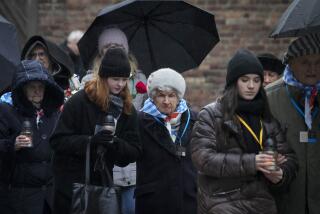Newly released photos suggest John Demjanjuk was Sobibor death camp guard
BERLIN — Two grainy black-and-white pictures showing a man authorities believe to be convicted Nazi collaborator John Demjanjuk working at the Sobibor death camp were published by German historians on Tuesday — surprise findings, 75 years after the Holocaust, that contradict the late U.S. autoworker’s steadfast claims that he was never there.
The pictures were part of a recently unearthed collection of private photos that once belonged to the deputy camp commander and show a young man resembling the Nazi identity card picture of Demjanjuk as he poses with other auxiliary guards at the Sobibor extermination camp in Nazi-occupied eastern Poland in early 1943.
“We believe it is probably Demanjuk in these pictures,” historian Martin Cueppers said Tuesday at a news conference in Berlin as he presented a total of 50 pictures from the camp. He added that camp documents and modern police biometric technology played a supporting role in reaching that conclusion.
“The timing fits right into the point when he was transferred to Sobibor on March 26, 1943,” said Cueppers, who is also the academic director at the Ludwigsburg Research Center at Stuttgart University. “We had a suspicion it was him and we were able to enlist the support of the state police. They used modern investigation tools such as biometrics to conclude ‘this is the same person’ as Demjanjuk.”
The pictures are historically significant because Ukrainian-born Demjanjuk had denied until his death that he had been at Sobibor. Little is known about the death camp, in part because the Nazis razed it in late 1943 after an uprising by about 600 inmates. Deputy camp commander Johann Niemann died, of ax wounds, along with a dozen guards.
An estimated 167,000 Jews were killed at Sobibor, using vehicle exhaust fumes, even though there were only about 20 German SS officers stationed at the camp. About 300 inmates escaped the camp after the uprising; there are only 58 known survivors.
Prosecutors had maintained that Demjanjuk was one of the Trawniki men — Central and Eastern European collaborators recruited from Nazi-run camps for Soviet prisoners of war — and served at the Sobibor, Majdanek and Flossenburg camps.
After an 18-month trial, Demjanjuk was convicted by a court in Munich in 2011 of being an accessory to the murder of about 28,000 Jews at Sobibor. He had appealed the conviction. He died in 2012 at the age of 91 in a nursing home in Germany, insisting that he was innocent.
He said he had been drafted into the Soviet army in 1941 and been a Ukrainian prisoner of war in Germany and Poland before immigrating to the United States after the war, changing his name from Ivan to John and settling in Seven Hills, Ohio, a Cleveland suburb. There, he raised a family and lived an unremarkable life until 1975, when he found himself on a list of American citizens believed to have once been Nazi guards.
“It’s an important development because this is a piece of hard evidence, and there was not a lot of hard evidence at Demjanjuk’s trial,” said Hajo Funke. The professor at Berlin’s Free University and expert on Germany’s Nazi past said it was “all by chance that these are coming to light, but it’s also significant to see all these pictures from Sobibor. Very little is known about it because there were so few survivors and hardly any images until now.”
Demjanjuk was stripped of his U.S. citizenship in 1981 and was extradited to Israel, where he was convicted in 1988 of crimes against humanity and sentenced to death. He was accused of murdering thousands of Jews at another Nazi camp, Treblinka, and identified as that camp’s notorious guard “Ivan the Terrible.” That conviction was overturned in 1993 when new evidence showed it to be a case of mistaken identity.
Demjanjuk returned to the United States, and his citizenship was restored in 1998. But the following year, U.S. prosecutors reopened the case. His citizenship was once again revoked, in 2002, and he was deported in 2009 to Germany, where he was charged with being an accessory to the murder of about 28,000 Jews at Sobibor. He was convicted in 2011 and sentenced to five years in prison. He was released pending the outcome of his appeal before his death the next year.
The Niemann collection — 361 pictures released to the public in Berlin on Tuesday — will be transferred to the U.S. Holocaust Memorial Museum in Washington, Cueppers said. He said a grandson of Niemann had found the album and turned it over to historians.
“This represents a quantum leap forward as far as visual records of the Holocaust in occupied Poland are concerned,” said Cueppers. He said the pictures and documents helped shed light on the workings of the notorious Operation Reinhard from 1941 to 1943, when 1.7 million Jews were killed at the Sobibor, Treblinka and Belzec death camps.
Historians say the pictures also show Niemann and other Nazi camp leaders leisurely having drinks around a table on a camp terrace on a hot summer afternoon, as well as Niemann on horseback, his eyes focused on train tracks as a deportation train is about to arrive. They also show some of the buildings around the camp. There are no pictures of inmates or gas chambers. There had been a strict ban on pictures, Cueppers said.
The pictures are also included in a new book, “Photos From Sobibor,” which was presented at Tuesday’s news conference, held at the Topography of Terror, a museum on the site of the former Gestapo headquarters in Berlin.
The Demjanjuk case was the subject of a five-part documentary series, “The Devil Next Door,” that Netflix released last year.
In an interview, Daniel Bloch, the co-director of the series, said of the newly released images: “They certainly seem to place him in Sobibor, but that isn’t a huge surprise given all the documentation that has placed him there before. So in a way, the pictures are meaningless. The story we already know, from evidence presented in the German trial, is that Demjanjuk was part of Germany’s machine of extermination, and like him there were a million others. Those small people were the real criminals who facilitated the extermination of millions and millions of innocent people, innocent people who were placed in gas chambers. Everyone involved in this horror was guilty.”
He added: “I think the need to positively identify Demjanjuk as ‘the guy who did the worst things’ is about wanting to achieve closure, closing the circle around what happened. But you can’t get closure for mass murder There is no such thing. Assuming the pictures reveal something real, as they appear, it just adds another layer of knowledge in the open account we have with anyone who commits horrors against other human beings.”
Kirschbaum is a special correspondent. Special correspondent Noga Tarnopolsky in Jerusalem contributed to this report.
More to Read
Sign up for Essential California
The most important California stories and recommendations in your inbox every morning.
You may occasionally receive promotional content from the Los Angeles Times.










